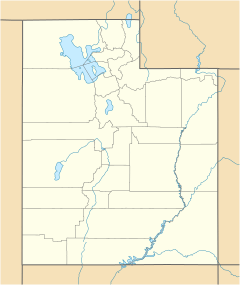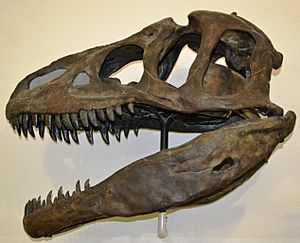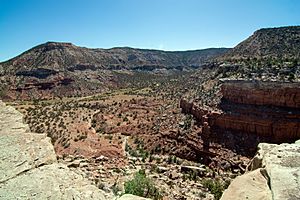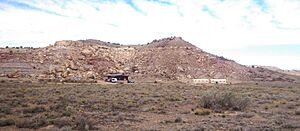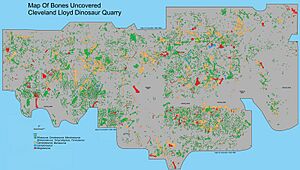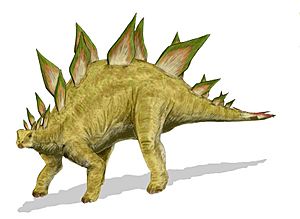Jurassic National Monument facts for kids
Quick facts for kids Jurassic National Monument |
|
|---|---|
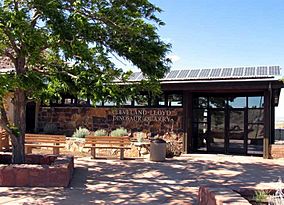
Cleveland-Lloyd Dinosaur Quarry Visitor Center
|
|
| Location | Emery County, Utah |
| Nearest city | Cleveland |
| Governing body | Bureau of Land Management |
| Designated: | 1965 |
The Jurassic National Monument, also known as the Cleveland-Lloyd Dinosaur Quarry, is a special place in Utah. It's famous for having the largest collection of Jurassic dinosaur fossils ever found in one spot. Imagine a huge pile of dinosaur bones!
This amazing site is located near Cleveland, Utah, in an area called the San Rafael Swell. The fossils are found in ancient rock layers known as the Morrison Formation.
Scientists have dug up over 15,000 bones here. There are still many more waiting to be discovered and studied. Because of its importance, it was named a National Natural Landmark in 1965. Later, in 2019, it became a national monument.
Many different types of dinosaur bones are mixed together here. Scientists used to think it was a "predator trap". This meant that meat-eating dinosaurs got stuck while hunting. However, now many believe a severe drought caused the deaths. There isn't one single answer everyone agrees on yet.
Contents
Visiting the Dinosaur Quarry
You can visit the Jurassic National Monument to learn more about dinosaurs. The Bureau of Land Management runs the visitor center.
Inside, you'll see a reconstructed skeleton of a large meat-eating dinosaur called an Allosaurus. There are also many other bones and exhibits. The visitor center was updated and expanded in 2007. It's open during certain seasons, so check their hours before you go!
A Look Back in Time: The Quarry's History
Sheepherders and cattlemen first found the quarry in the late 1800s. They were moving their animals through the area. In 1927, the University of Utah started collecting bones. They found about 800 bones.
Later, from 1939 to 1941, a team from Princeton University came to dig. This team was led by William Lee Stokes, who is known as the "Father of Utah geology." They collected 1,200 bones. The site was named Cleveland-Lloyd Quarry because it was near Cleveland, Utah, and Malcolm Lloyd helped pay for the expeditions.
Some of these bones went to Princeton. They were used to create a full Allosaurus skeleton. This skeleton was put on display in 1961. It was likely the first Allosaurus skeleton from the quarry to be shown to the public.
After World War II, digging started again in 1960. A young paleontologist named James Henry Madsen Jr. joined the University of Utah team. He worked with William Lee Stokes.
In 1960, Stokes and Madsen started the "University of Utah Cooperative Dinosaur Project." This project shared dinosaur casts and specimens with museums worldwide. In return, they received money and help with digging.
Madsen later described new dinosaurs found at the quarry. In 1974, he named Stokesosaurus clevelandi after his mentor, William Lee Stokes. In 1976, he named Marshosaurus bicentesimus after another paleontologist, Othniel Charles Marsh. In 1987, scientists from Brigham Young University found a fossil dinosaur egg. It was the oldest one ever found at that time.
Over the years, more than 12,000 fossil bones have been collected. Most of the original fossils are kept at the Natural History Museum of Utah. However, copies of these dinosaur skeletons are on display in over 65 museums around the world. You can see original fossils in Utah at museums in Salt Lake City, Price, and Provo.
The Bureau of Land Management opened a visitor center at the quarry in 1968. It was the very first visitor center they ever opened! A new, bigger center with modern exhibits opened in 2007. This new center even makes its own electricity using solar panels.
In early 2019, the quarry officially became the "Jurassic National Monument."
The Earth's Story: Geology of the Quarry
The Cleveland-Lloyd Dinosaur Quarry is famous for its many dinosaur bones. These bones are found in the Upper Jurassic rock layers of North America. The quarry is part of a specific rock unit called the Brushy Basin Member of the Morrison Formation.
The fossils are in a type of clay-rich mudstone. This mudstone formed in a "floodpond" on a wide river plain. This area had many connected river channels.
Scientists believe dinosaurs came to this floodpond during a drought. They were looking for water. Plant-eating dinosaurs and smaller meat-eaters might have become stuck. Then, larger meat-eaters like Allosaurus might have come to feed on them. As the drought got worse, even Allosaurus might have eaten younger Allosaurus to survive.
Most of the fossils found here are dinosaurs. The most common is Allosaurus, with bones from at least 44 individuals. Other meat-eaters include Torvosaurus, Ceratosaurus, Stokesosaurus, Marshosaurus, and Tanycolagreus. Plant-eating dinosaurs found here include Camarasaurus, Diplodocus, Barosaurus, Apatosaurus, Camptosaurus, and Stegosaurus. There are also fossils of crocodiles, turtles, and snails.
For a long time, scientists wondered why there were so many meat-eating dinosaurs compared to plant-eaters. Some thought Allosaurus might have hunted in packs. They believed the dinosaurs got stuck in the mud while hunting. However, newer studies suggest the mass deaths were due to a drought. Like the La Brea Tar Pits, dinosaurs might have come for water and died from the harsh conditions. They might have also gotten sick from contaminated water. Many young Allosaurus fossils support this idea.
Ancient Life: Paleobiota
Here are some of the types of ancient life found at the Cleveland-Lloyd site:
Plants
- Aclistochara
- Latochara
- Stellatochara
Snails
- Amplovalvata
- Amplovoluta
- Valvata
- Viviparus
Turtles
- Glyptops
Dinosaurs
Bird-hipped Dinosaurs (Ornithischians)
- Camptosaurus
- Stegosaurus (This was the largest bird-hipped dinosaur found here.)
Long-necked Dinosaurs (Sauropods)
- Apatosaurus
- Barosaurus
- Camarasaurus (Three skeletons of this dinosaur were found.)
- Diplodocus
Meat-eating Dinosaurs (Theropods)
- Allosaurus (This was the largest meat-eating dinosaur found here, with many individuals.)
- Ceratosaurus (This is the rarest meat-eating dinosaur species found here.)
- Marshosaurus
- Stokesosaurus (This was the largest coelurosaur found here.)
- Tanycolagreus
- Torvosaurus
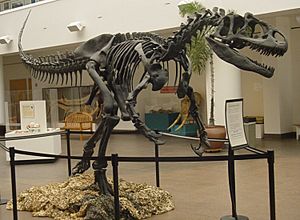
See also


